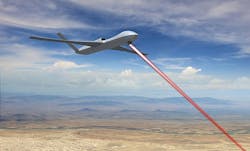Lockheed Martin to develop UAV low-power laser weapons with an eye to countering ballistic missiles
Officials of the U.S. Missile Defense Agency (MDA) in Albuquerque, N.M., announced a $9.4 million contract on Thursday to the Lockheed Martin Space Systems segment in Sunnyvale, Calif., for the first phase of the Low Power Laser Demonstrator (LPLD) project.
Lockheed Martin engineers will build a low-power laser prototype to help establish beam stability at long range and the ability to dwell on one spot of a ballistic missile-sized target.
The contract calls for Lockheed Martin perform the next step for the LPLD effort, which is to addresses laser power and aperture size by integrating and testing a low-power laser on UAV.
Related: New drone laser weapon could stop enemy missiles in boost phase
The LPLD project is to develop enabling technologies in preparation for developing and testing a future high-energy laser weapon for a high-altitude UAV that will seek to destroy enemy ballistic missiles in boost phase.
Destroying enemy ballistic missiles in boost phase is particularly beneficial because with one shot it could destroy multiple independently targeted missile warheads, as well as decoys designed to foil missile defenses.
Lockheed Martin may not be the only company to be involved in the LPLD project. MDA officials say they expect to award two LPLD contracts this year for a two-phase demonstration program.
The yearlong first phase is for system design, and the second phase will build, integrate, and test a functional low-power laser for beam control and stability. MDA officials anticipate a low-power flight test by 2020 and beam stability testing by 2021.
Lessons learned from the LPLD project are expected to help government and industry experts develop solid-state lasers strong enough to destroy enemy ballistic missiles in boost phase from UAVs operating at high altitudes.
The LPLD project's low-power laser demonstrator should help military and defense industry experts understand how to use high-altitude UAVs to destroy missiles in boost phase with lasers, and ways to aim the laser, keep it steady on target, and focus the laser sufficiently to destroy the missile at it leaves the launch pad.
On this contract Lockheed Martin will do the work in Sunnyvale and Palo Alto, Calif., Louisville, Colo.; and Albuquerque, N.M., and should be finished by July 2018.
For more information contact Lockheed Martin Space Systems online at www.lockheedmartin.com/us/ssc.html, or the Missile Defense Agency at www.mda.mil.
Ready to make a purchase? Search the Military & Aerospace Electronics Buyer's Guide for companies, new products, press releases, and videos
